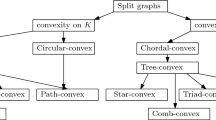Abstract
The simple max-cut problem is as follows: given a graph, find a partition of its vertex set into two disjoint sets, such that the number of edges having one endpoint in each set is as large as possible. A split graph is a graph whose vertex set admits a partition into a stable set and a clique. The simple max-cut decision problem is known to be NP-complete for split graphs. An indifference graph is the intersection graph of a set of unit intervals of the real line. We show that the simple max-cut problem can be solved in linear time for a graph that is both split and indifference. Moreover, we also show that for each constant q, the simple max-cut problem can be solved in polynomial time for (q,q-4)-graphs. These are graphs for which no set of at most q vertices induces more than q-4 distinct P 4’s.
Access this chapter
Tax calculation will be finalised at checkout
Purchases are for personal use only
Preview
Unable to display preview. Download preview PDF.
Similar content being viewed by others
References
Arbib, C.: A polynomial characterization of some graph partitioning problem. Inform. Process. Lett. 26, 223–230 (1987/1988)
Babel, L.: On the P4-structure of graphs, Habilitationsschrift, Zentrum für Mathematik, Technische Universität München (1997)
Babel, L., Kloks, T., Kratochvíl, J., Kratsch, D., Müller, H., Olariu, S.: Efficient algorithms for graphs with few P4’s. Combinatorics (Prague, 1998). Discrete Math. 235, 29–51 (2001)
Babel, L., Olariu, S.: On the structure of graphs with few P4s. Discrete Appl. Math. 84, 1–13 (1998)
Baumann, S.: A linear algorithm for the homogeneous decomposition of graphs, Report No. M-9615, Zentrum für Mathematik, Technische Universität München (1996)
Bodlaender, H.L., Jansen, K.: On the complexity of the maximum cut problem. In: Enjalbert, P., Mayr, E.W., Wagner, K.W. (eds.) STACS 1994. LNCS, vol. 775, pp. 769–780. Springer, Heidelberg (1994); Also in Nordic J. Comput. 7(1),14–31 (2000)
Bodlaender, H.L., Kloks, T., Niedermeier, R.: Simple max-cut for unit interval graphs and graphs with few P4’s. In: Extended abstracts of the 6th Twente Workshop on Graphs and Combinatorial Optimization, pp. 12–19 (1999); Also in Electronic Notes in Discrete Mathematics 3 (1999)
Bogart, K.P., West, D.B.: A short proof that ‘proper = unit’. Discrete Math. 201, 21–23 (1999)
Brandstädt, A., Le, V.B., Spinrad, J.P.: Graph Classes: a Survey. SIAM Monographs on Discrete Mathematics and Applications. Society for Industrial and Applied Mathematics (SIAM), Philadelphia, PA (1999)
de Figueiredo, C.M.H., Meidanis, J., de Mello, C.P.: A linear-time algorithm for proper interval graph recognition. Inform. Process. Lett. 56, 179–184 (1995)
Eskin, E., Halperin, E., Karp, R.M.: Large scale reconstruction of haplotypes from genotype data. In: RECOMB 2003, pp. 104–113. ACM Press, New York (2003)
Giakoumakis, V., Roussel, F., Thuillier, H.: On P4-tidy graphs. Discrete Mathematics and Theoretical Computer Science 1, 17–41 (1997)
Goemans, M.X., Williamson, D.P.: Improved approximation algorithms for maximum cut and satisfiability problems using semidefinite programming. J. ACM 42, 1115–1145 (1995)
Golumbic, M.C.: Algorithmic Graph Theory and Perfect Graphs. Academic Press, New York (1980)
Gramm, J., Hirsch, E.A., Niedermeier, R., Rossmanith, P.: Worst-case upper bounds for MAX-2-SAT with application to MAX-CUT. Discrete Appl. Math. 130(2), 139–155 (2003)
Hadlock, F.O.: Finding a maximum cut of a planar graph in polynomial time. SIAM J. Comput. 4, 221–225 (1975)
Jamison, B., Olariu, S.: A tree representation for P4-sparse graphs. Discrete Appl. Math. 35, 115–129 (1992)
Jamison, B., Olariu, S.: Recognizing P4-sparse graphs in linear time. SIAM J. Comput. 21, 381–406 (1992)
Jamison, B., Olariu, S.: Linear time optimization algorithms for P4-sparse graphs. Discrete Appl. Math. 61, 155–175 (1995)
Jamison, B., Olariu, S.: p-components and the homogeneous decomposition of graphs. SIAM J. Discrete Math. 8, 448–463 (1995)
Karp, R.M.: Reducibility among combinatorial problems. In: Miller, R.E., Thather, J.W. (eds.) Complexity of computation, pp. 85–103 (1972)
Kloks, T., Tan, R.B.: Bandwidth and topological bandwidth of graphs with few P4’s. In: 1st Japanese-Hungarian Symposium for Discrete Mathematics and its Applications, Kyoto, pp. 117–133 (1999); Discrete Appl. Math. 115(1-3), 117–133 (2001)
McKee, T.A., Morris, F.R.: Topics in Intersection Graph Theory. SIAM Monographs on Discrete Mathematics and Applications. Society for Industrial and Applied Mathematics (SIAM), Philadelphia, PA (1999)
Orlova, G.I., Dorfman, Y.G.: Finding the maximal cut in a graph. Engrg. Cybernetics 10, 502–504 (1972)
Ortiz, C., Maculan, Z.N., Szwarcfiter, J.L.: Characterizing and edge-colouring split-indifference graphs. Discrete Appl. Math. 82(1-3), 209–217 (1998)
Poljak, S., Tuza, Z.: Maximum cuts and large bipartite subgraphs. In: Cook, W., Lovász, L., Seymour, P. (eds.) DIMACS Series in Discrete Mathematics and Theoretical Computer Science, Providence, RI. Amer. Math. Soc., vol. 20, pp. 181–244 (1995)
Rizzi, R., Bafna, V., Istrail, S., Lancia, G.: Practical algorithms and fixedparameter tractability for the single individual SNP haplotypying problem. In: Guigó, R., Gusfield, D. (eds.) WABI 2002. LNCS, vol. 2452, pp. 29–43. Springer, Heidelberg (2002)
Roberts, F.S.: On the compatibility between a graph and a simple order. J. Combinatorial Theory Ser. B 11, 28–38 (1971)
Wimer, T.V.: Linear algorithms on k-terminal graphs, PhD Thesis, Department of Computer Science, Clemson University, South Carolina (1987)
Author information
Authors and Affiliations
Editor information
Editors and Affiliations
Rights and permissions
Copyright information
© 2004 Springer-Verlag Berlin Heidelberg
About this paper
Cite this paper
Bodlaender, H.L., de Figueiredo, C.M.H., Gutierrez, M., Kloks, T., Niedermeier, R. (2004). Simple Max-Cut for Split-Indifference Graphs and Graphs with Few P 4’s. In: Ribeiro, C.C., Martins, S.L. (eds) Experimental and Efficient Algorithms. WEA 2004. Lecture Notes in Computer Science, vol 3059. Springer, Berlin, Heidelberg. https://doi.org/10.1007/978-3-540-24838-5_7
Download citation
DOI: https://doi.org/10.1007/978-3-540-24838-5_7
Publisher Name: Springer, Berlin, Heidelberg
Print ISBN: 978-3-540-22067-1
Online ISBN: 978-3-540-24838-5
eBook Packages: Springer Book Archive




